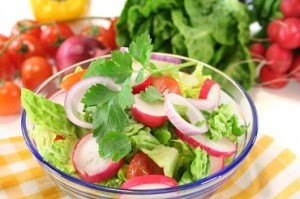By Jake Gates
Continued from part 1 of this article…..
 So how do you get more fiber in your diet? Here are some ideas:
So how do you get more fiber in your diet? Here are some ideas:
• Eat more fruits and vegetables, which are high in fiber. MyPlate.gov recommends filling half your plate with fruits and vegetables. Fruits high in fiber include raspberries (8 g per cup), pears (5.5 g per pear), and apples (4.4 g per apple). High-fiber vegetables include artichokes (10.3 g per artichoke), green peas (8.8 g per cup), and broccoli (5.1 g per cup).
• Swap out white-flour foods for foods filled with fiber. For example, whole wheat spaghetti has 6.3 g fiber per cup, brown rice has 3.5 g per cup, and whole wheat bread has 1.9 g per slice.
• Fit more legumes, nuts, and seeds into your diet. Split peas have 16.3 g per cup, lentils have 15.6 per cup, and almonds have 3.5 g per ounce. [7]
Powerful Protein
Contrary to popular belief, protein can be your friend when you’re trying to curb your appetite. Research shows high protein diets lead to satiety and weight loss. High-protein meals also reduce food intake after a meal. [8]
In one study, women were assigned to a diet of 68 g/day protein (a carbohydrate to protein ratio of 3.5), or 125 g/day protein (a ratio of 1.4). The higher protein group lost more weight, and lost a higher rate of fat, compared with the lower protein group. The protein group also reported greater satiety. Scientists concluded increasing protein to carb ratios improves body composition and satiety.[9]
How much protein should you eat? About 10 to 35% of your daily calories should come from protein foods (46 g for women and 56 g for men). This is easy to get: a typical 8-ounce piece of meat has over 50 g protein. [10]
It’s also important to remember not all protein sources are created equal. Here are the healthiest protein sources that will keep you full without spiking your calorie count:
 • Eggs are low in calories and can keep you full for several hours.
• Eggs are low in calories and can keep you full for several hours.
• Fish is low in fat and high in omega-3 fatty acids, which reduce cholesterol. Fish may also conserve muscle mass to speed metabolism.
• Low-fat dairy like skim milk and yogurt may prevent fat storage and raise metabolism.
• Tofu, beans, and peas all contain protein, but are lower in calories than most meats. [11]
• Lean meats like turkey and chicken are generally a better choice than higher-fat meats like beef and pork.
So, what are you waiting for? Hit the grocery store for more sources of water, fiber, and protein, and start curbing your appetite today!
References
[7] “Chart of high-fiber foods.” MayoClinic.com. Available from: http://www.mayoclinic.com/health/high-fiber-foods/NU00582
[8] Thomas L. Halton and Frank B. Hu. “The Effects of High Protein Diets on Thermogenesis, Satiety and Weight Loss: A Critical Review.” J Am Coll Nutr. 2004; 23 (5): 373-385. Available from: http://www.jacn.org/content/23/5/373.short
[9] Donald K. Layman et al. “A Reduced Ratio of Dietary Carbohydrate to Protein Improves Body Composition and Blood Lipid Profiles during Weight Loss in Adult Women.” J. Nutr. 2003; 133 (2): 411-417. Available from: http://jn.nutrition.org/content/133/2/411.short
[10] “How Much Protein Do You Need?” WebMD.com. Available from: http://www.webmd.com/diet/healthy-kitchen-11/how-much-protein?page=1
[11] Sarah Dray. “The Best Sources of Protein for Weight Loss.” Available from: http://www.livestrong.com/article/347406-the-best-sources-of-protein-for-weight-loss
– Jake Gates is a freelance writer in the field of health and fitness for AppetiteSuppressants.org. He specializes in healthy living and nutrition and is passionate about contributing to his community as well as coach a local high school lacrosse team.
